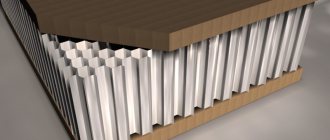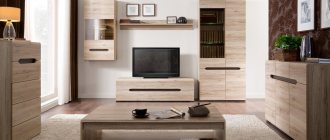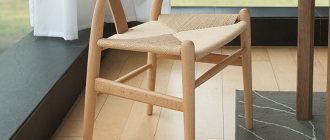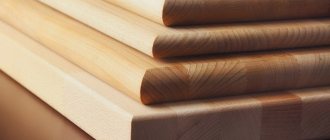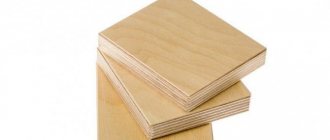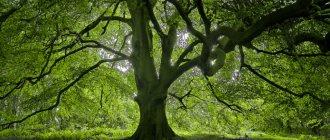Over the past few years in Moscow, the demand for solid massive furniture, which is assembled from 32-60 mm elements, has increased significantly. Interesting design developments, excellent aesthetics and respectability have ensured rapid growth in popularity for such products. At the same time, until quite recently, the technological capabilities of domestic manufacturers did not allow them to satisfy the urgent needs of the market. First of all, difficulties arose with the high cost of such products and the limited choice of raw materials for the production of modern models. In addition, furniture made using old technologies was literally too massive and put a significant load on the walls and ceilings.
The problem was solved in Europe several years ago through the development and subsequent mass production of a new material - tambourate. At first, furniture made from it had the same high cost as analogue models made from traditional materials. By the way, in Russia such models were even more expensive. However, the development of production capacity and the availability of this material for factories with average production capacity have made it possible to reduce the retail price of prestigious and stylish tambourate furniture.
The Stiver-100 company was one of the first to evaluate the characteristics of this new material and master the technologies for its processing. We make custom-made furniture from vestibule at competitive prices for clients from Moscow and neighboring regions. We managed to add newness to even obsolete but still popular serial models, as well as develop fundamentally new exclusive headsets. Our new product line looks creative and unconventional, it is durable and easy to use. To better understand what kind of furniture we offer you, we recommend that you read the material about the operational and aesthetic characteristics of the vestibule.
Main characteristics and advantages of tambourate
Tamburat (Eurolight) - frameless lightweight slabs with three separate layers, designed for the manufacture of modern, eye-catching furniture. Its appearance in the 2000s was a real surprise for manufacturers of headsets and interior items. Since then, the popularity of this material has been steadily growing throughout the world, including Russia. Tamburat made it possible to reduce the cost of respectable furniture, and at the same time significantly reduced its weight. Thanks to these plates, it was possible to establish in-line production of previously exclusive models, making them available to a wide consumer audience.
Tamburat has another name - “honeycomb slabs”, which reflects its structure. To reduce the weight of furniture made using this material, lightweight cellular cardboard is used for the internal filling of double-sided boards. Traditional HDF, laminated chipboard or MDF boards with a thickness of 3 are used as outer layers for the production of tambourate; 4 or 8 millimeters. This design allows, without compromising performance characteristics, to reduce the weight of furniture by 40%.
The thickness of the vestibule slabs varies between 38-100 mm, which removes almost any restrictions in the manufacture of visually massive furniture, which in reality is no heavier than products made from 16-18 mm laminated chipboard or MDF. The idea of creating such slabs was borrowed from door manufacturers. The strength of tambourate products is beyond doubt, since all technologies have been tested for many years on interior door leaves. “Honeycomb boards” (Eurolight) have proven themselves excellent in the production and operation of furniture due to the following advantages:
- availability of all methods of classical processing - sawing, edging, veneer finishing, milling, drilling, as well as insertion of built-in elements
- Possibility of hidden cable installation and installation in any area of the furniture structure
- compatibility with traditional furniture fittings and easy installation of auxiliary mechanisms
- pressure strength, as well as excellent deflection performance of workpieces under high vertical load
- the ability to maintain the original shape of workpieces unchanged in all planes
- a wide selection of finishing decorative coatings from EGGER and other well-known chipboard manufacturers
- low weight in relation to the dimensions of the workpieces
- versatility and wide range of applications
- favorable price in comparison with other materials of similar thickness.
The operation of furniture made from tambourate has proven in practice that products made from Eurolight are not inferior in reliability and durability to analogues made from paired laminated chipboards. The cellular board used to fill the internal cavities is shaped like a hexagonal endless honeycomb, providing outstanding mechanical and flexural strength. Tamburat sheets have a format of 2800x2070 millimeters and, depending on the thickness and type of facing slabs, have a mass of 70 to 80 kg, which is slightly greater than the weight of laminated chipboard (16-18 mm). Tamburat organically combines physical, technological and economic indicators. This material can easily withstand loads from 1.3 to 3.5 kgf (kgf), thanks to which tambourate furniture has an additional margin of safety, which is more than enough to protect products from mechanical damage: dents, cracks, etc.
Tamburat, doors, sandwich panels
Barberan SA (Spain) is a leader in the design and manufacture of equipment for gluing various materials using hot melt adhesives applied using roller glue applicators.
One of the applications of this technology in light industry was the production of door leaves and similar structures (tambourate) with honeycomb core, sandwich panels from various materials (production of sandwich panels)
together with Barberan SA we can offer our customers various solutions for any specific tasks.
In particular, existing experience allows us to produce lines for the production of door panels with honeycomb core with a productivity of up to 4 units/min.
Description of technology.
The traditional method of producing doors with honeycomb core is based on the use of urea-formaldehyde resins or PVA adhesives. Activation of the glue occurs during hot pressing on flat presses.
We offer another solution that will reduce glue and labor costs with the same or greater productivity.
The technology is based on the use of polyurethane hot melt adhesives, which do not require high pressing pressures and high temperatures to activate the adhesive. For gluing, it is enough to compress the workpieces for a short time; in the simplest line options, roller presses are used. After which the workpieces can be transported, stored, and within a few minutes it is possible to perform formatting operations.
The cost of PU hot melt adhesive is still higher compared to CF or PVA adhesives, however, the process of assembling panels using the proposed technology is a more profitable process in terms of cost reduction.
Hot melt adhesive is not applied to the entire MDF panel, but to the frame with stretched honeycomb core inside, that is, the glue is applied only in those places where it is really needed. In this way, we significantly reduce the specific amount of glue.
An example of calculating the cost of glue for a door with dimensions of 2200 x 710 mm.
Conventionally, we take the cost of the cheapest KF glue as 100 units/kg, then the cost of PVA is 200 units/kg, PU melt is 500 units/kg.
- PU glue
- Gluing surface area:
- 3 short beams 650 mm x 30 mm x 3 = 0.059 m2
- 2 long beams 2200 mm x 30 mm x 2 = 0.132 m2
- Honeycomb core 2200 mm x 710 mm x 1/25 = 0.062 m2
- Total surface area = 0.25 m2
- Area of both sides = 2 x 0.25 = 0.5 m2
Using PU glue, apply 100 g/m2 x 0.5 m2 = 50 g. / door leaf The cost of glue in the price of the door leaf is 25 units.
- CF glue – PVA glue
- Gluing surface:
- MDF sheet 2200 mm x 710 mm = 1.56 m2
- Total surface area = 2 x 1.56 = 3.12 m2
- Using CF/PVA glue, apply 200 g/m2 x 3.12 = 624 g/door leaf
The cost of KF glue in the price of the canvas is 62.4 units. The cost of PVA glue in the price of the canvas is 125 units.
TOTAL, the cost of glue in the price of the door leaf:
- PU glue…..25 Units per 1 door
- KF glue……..62.4 Units per 1 door
- PVA glue…….125 Units per 1 door
As calculations show, in reality the use of PU adhesives is more profitable, despite the higher cost.
According to our clients, the cost of glue, which is used only for assembling the door leaf, is about 5% of the selling price. Thus, savings when switching to new technology can amount to 3-4%
In addition, the proposed technology has a number of other advantages.
The productivity of the simplest set of equipment is about 1 door per minute.
To achieve similar productivity with flat hot presses, a 10-bay multi-bay press with all the necessary equipment (with a pressing time of 5 minutes) will be required.
To work on the simplest line using the technology described above, 1-2 people are required to place the honeycomb core into the door frame and feed the workpiece into the line, 1 operator to control and monitor the operation of the equipment. 1 worker – for stacking doors at the exit of the line. On lines applying CF or PVA adhesives, the number of operators is at least twice as large.
The energy consumption of lines based on hot flat presses is significantly higher.
THE SPECIFIED ADVANTAGES GIVE REASON TO BELIEVE THAT THIS TECHNOLOGY IS THE FUTURE IN THE PRODUCTION OF LIGHTWEIGHT DOORS WITH HONEYCOMB FILLER.
IF YOU ARE INTERESTED, WE ARE READY TO DEMONSTRATE THE OPERATION OF THE LINE IN THE LABORATORY OF THE MANUFACTURER – BARBERAN SA (SPAIN).
Description of line equipment.
The main criterion influencing the composition of the line is the planned productivity. Based on the data, the option of a glue application machine and glue melter, the option of feeding blanks into the line and their assembly, and pressing equipment are selected.
A typical automatic line includes the following machines.
- 1. Feed conveyor.
- 2. Glue-applying machine.
- 3. Device for supplying door skins.
- 4. Door trim positioning device.
- 5. Press.
- 6. Outgoing conveyor.
Line duty cycle.
The operator places the door frame with stretched and fastened honeycomb core on the feed conveyor and bases it relative to the guide. At the same time, the door trim feeder moves trim #1 to the positioning device, which moves it to the assembly location.
The door frame with glue applied on both sides is automatically laid on pad No. 1, which is lying with the inside facing up. At this time, the door trim feeder moves trim No. 2 to the positioning device, which places it upside down around its axis (i.e., with the inside facing down).
There are many options for pavers and turners available specifically for each project. When choosing a particular model, productivity, type of glued construction materials, and production logistics are taken into account. The option described above is shown in the figure on the right.
The finished semi-finished product is sent to the press, after which the finished product is delivered to the output conveyor.
The line allows you to produce up to 2 canvases per minute.
Video of the line operation:
Double Sided Hot Melt Glue Applying Machine
Assembly of door panels in semi-automatic lines occurs manually.
The process is shown schematically in the figure.
The door frame with the honeycomb filling fixed after the glue-applying machine at the front end is based on a special carriage (Fig. 1), which allows the workpiece to be completely positioned above the door trim blank without touching it (Fig. 2). The door trim must first be laid by the operator on a work table with a tilting surface.
Having completely exited the glue-applying machine, the workpiece with its rear end falls onto the door trim (Fig. 3), and the operator lays the front end of the door leaf frame (Fig. 4), removing the carriage from under it. The table takes a horizontal position.
After laying the frame, the operator moves the rack towards him and takes the top cover, removes it, bases it along the guide and places it on top of the frame (Fig. 5). Then he sends the assembled “sandwich” to the press.
Video:
The pictures show tables for manual assembly of glued structures.
The bottom picture shows a table with a carriage and a shelving unit.
Depending on the productivity, type of glued structure, requirements for the quality of the finished product, pressing equipment is also selected. In one case, a roller press is sufficient. For other tasks, such as assembling doors from MDF panels with extruded panels, only a smooth press with a through-pass system for blanks, which ensures uniform compression over the entire area at the same time, is suitable.
As you can see, the number of solutions that we can offer you is enormous. We will be happy to meet with you to discuss any project and make you the best offer.
Area of application of tamburat
Being a universal material, tamburate is suitable for the production of almost any furniture that can be used in home, office, retail, municipal and educational premises. The expediency of using this material is due to the fact that, in addition to excellent aesthetic characteristics, products made from honeycomb slabs place minimal load on load-bearing structures. That is, massive-looking furniture turns out to be no heavier than sets made from laminated chipboard or MDF with a thickness of 18-28 mm. Thanks to these qualities, Eurolight tambour slabs have found application in the production of:
- kitchen sets
- shelving structures of all types, including those with long shelf lengths
- exhibition equipment
- bedrooms
- wall shelves and cabinets
- living room furniture
- any modifications of tables
- furniture for children's rooms
- reception desks
- banking equipment
- catering furniture
Massive furniture in spacious rooms looks much more organic than similar models made from thin slabs. In addition, due to their good soundproofing properties, vestibule panels can be used for zoning space and constructing interior partitions, including sliding ones. If the outer cladding of Eurolight boards is made of MDF or HDF sheets, then this material is suitable for the manufacture of convex parts - bent facades and other curved structural elements.
There is an opinion among some sellers and furniture manufacturers that tambourate is only suitable for the manufacture of conceptual modern models. This is a serious mistake that misleads some customers. A wide range of cladding slab decors ensures compatibility of vestibule furniture with interiors decorated in any style. You just need to choose the right material and develop an appropriate design project. The staff of the Stayver-100 company will easily design and manufacture bedrooms, living rooms, wardrobes, offices and kitchens for rooms with a classic interior. The presence of veneered tambourate with the possibility of applying matte, semi-matte or glossy varnish to its surface opens up additional opportunities for manufacturers and allows them to fulfill orders for the production of luxury premium furniture.
Application of tambourate
Modern design dictates simple, laconic forms, but, at the same time, gives them a feeling of reliability and at the same time naturalness and naturalness. And the simplest and most popular way to achieve such solutions is to use visually thicker elements. And here slabs with honeycomb filling come to the rescue - light furniture slabs (tamburat). They combine the required thickness and at the same time have low weight. This allows them to be constructively used as various elements of furniture and at the same time not to depend on the excess weight of the products. There are indeed a lot of options for using honeycomb plates in products. But, as a rule, these are the elements that first of all attract attention.
Honeycomb boards are most widely used in furniture for living rooms, dressing rooms, and shelving systems. At the same time, they can be found in the bedroom, kitchen, office - almost everywhere. In addition to these examples, hundreds more can be named. The use of honeycomb slabs is multifaceted. This could be children's furniture, hotel furniture or a dining room group. But wherever they are used, they act as the main decorative element, that is, a simple combination of thick and thin slabs in a product is the main idea of such compositions. This is what modern design dictates: conciseness and completeness of forms.
Tambourate edging
For gluing tambourate parts, PVC edges with a thickness of 1.5-3 mm are mainly used. If Eurolight sheets are covered with 8 mm thick slabs, the edge can be applied using standard technology without any preparatory measures. For all other cases, it is recommended to additionally use a support edge, which is a flexible tape made of foamed ABS, the thickness of which is 3 mm. It serves as a reliable basis for subsequent application of decorative polyvinyl chloride edges to the ends.
Regardless of the thickness of the facing sheets, you should not use melamine edges to finish the ends of tambourate parts. If Eurolight panels have a decorative coating of natural veneer, then strips of similar veneer of the appropriate width are used to cover the ends, and it is advisable to apply the veneer to the supporting edge of ABS. In this case, the lining of the ends of the veneered vestibule is carried out before applying varnish to the front surfaces in order to avoid repeated paintwork.
CELL FILLER
CELL FILLER - the most amazing and promising material today for the manufacture of ultra-light and durable structures of increased thickness TAMBURAT-RU. Honeycomb core (CH) is a cellular structure, the shape of the cells repeats the shape of a honeycomb, hence the name honeycomb.A LITTLE HISTORY The honeycomb was first made, surprisingly, by circus owner George May in 1943. The material turned out to be very successful and has found wide application in military equipment. Although paper honeycomb is no longer used in aircraft construction, about half the doors in the world have it between the layers of cladding. In recent years, it has been increasingly used in the furniture industry. WHERE AND HOW WE USE CELLS Firstly, This is the production of lightweight furniture boards, panels, structures and elements of increased thickness TAMBURAT-RU up to 100 mm, where the physical and mechanical properties of materials are perfectly combined. For example, as the thickness of the honeycomb increases, the strength of the panels increases, while the weight of such a structure increases slightly. A “furniture” honeycomb measuring 2000x800x50 mm weighs only about 1.5 kg, now compare this figure with the weight of such a panel made of chipboard - 58 kg. When producing lightweight furniture panels with TAMBURAT-RU core up to 100 mm, you are not limited in your imagination by the boring standard thicknesses that are offered today by domestic manufacturers and the Western market, for example, chipboard, the maximum thickness of which is 38 mm.
TAMBURAT-RU - this is the possibility of manufacturing furniture panels with curved shaped front surfaces, when in the right places the honeycombs are “pressed” by panel sheathing during the gluing process. Secondly, These are almost all interior doors: excellent quality with high manufacturing technology, unique consumer properties and the ability to withstand significant impact loads. Third, This is the use of honeycomb cores in the production of unique non-returnable pallets, pallets for storing and transporting goods with a load of 350 to 1200 kg. In this case, there is no need to use pallets as return packaging, which is very convenient when solving long transport and logistics problems. In addition, you can place symbols and additional advertising of your products on the pallets, which will make it possible to attract a new audience of customers and increase sales volumes for your company. This advertising solution can be used to improve service or as rebranding steps for companies. Transport and storage pallets made of honeycomb cores They have standard sizes 1200x800 and 1200x1000, but can be made to individual sizes if cargo transportation conditions require it. At the end of their use, the pallets are handed over to collection points for recycling waste paper, or are easily disposed of without harming the environment.
STRUCTURAL COMPONENTS AND PHYSICAL AND MECHANICAL PROPERTIES Honeycomb core is a complex structure consisting of at least two materials - paper (cardboard) and glue. It follows that, with equal geometric parameters, the physical and mechanical properties of SZ significantly depend on the properties of paper and glue. Glue. In the production of honeycomb core, both in our country and abroad, PVA dispersion is most often used and this is explained by the environmental friendliness of this adhesive and high manufacturability. Paper (cardboard). The most commonly used paper or cardboard is recycled paper with a weight of 140 to 175 gsm. m. However, honeycomb core made from cellulose (kraft) cardboard has the best strength characteristics and the most stable parameters. Strength. The decisive mechanical parameter for SZ is the compressive strength. This characteristic is the most significant both during the processing of honeycombs into products and during their further operation. Compressive strength increases as the cell size decreases and/or the density of the paper (cardboard) used increases. The compressive strength increases two or more times when the production of honeycomb core is switched from waste paper to cellulose cardboard. Only a sufficient supply of this indicator can guarantee the absence of technological problems in the use of honeycomb core in further processing. Other physical properties. Honeycomb core, consisting of up to 95% air, has good sound and heat insulation and excellent energy absorption.
PRODUCTION OF HONEYCOMB FILLER According to the world community, the most advanced technology for the production of honeycomb filler is in the form of a continuous strip.
It is distinguished by high productivity and quality of honeycomb core. In the production process of honeycomb core, only high-quality high-density cellulose cardboard (kraft cardboard) and special grades of honeycomb cardboard are used, which qualitatively distinguishes these products from the line of proposals for honeycomb core. Based on the well-known truth that the quality of raw materials ultimately determines the quality of the finished product, having knowledge, experience and modern automated production lines, the production of SZ doubles every year in the world, which allows, at a high level of costs for raw materials, to remain at the level of competitive prices for honeycomb core. One of the technological lines for the production of honeycomb core
We are confident that our company’s products are products that can fully satisfy the growing needs of Russian furniture manufacturers, in the near future and in the future, for light and durable panels, as well as structural elements of increased thickness Tamburat-RU with with the goal of achieving the most interesting and market-demanded design and technological solutions.
Tamburat-RU is a modern engineered wood structural and design material in which, without compromising strength, rigidity and other indicators, it was possible to achieve maximum weight reduction by creating a “sandwich” structure in which the middle layer is made of cellular cardboard (honeycomb) . Honeycomb cells ensure high stability of the panel - and even long (3 meters) lightweight Tamburat-RU furniture panels can withstand significant loads without additional supports.
Accessories for vestibule
Although some experts argue that traditional fittings can be used for a stool lined with 8 mm thick slabs, it is still better to give preference to specialized fasteners that were specifically designed to compensate for voids in the honeycomb filling of the slabs. The most authoritative and well-known manufacturer of accessories for vestibules is the German company Hafele, which produces all the necessary elements for high-quality assembly of Eurolight furniture:
- Rafix 20 HC nickel-plated – designed for fastening horizontal and vertical parts with a thickness of 32-50 mm
- Tab 20 HC nickel plated – provides connection of tambourate slabs 32-60 mm
- Maxifix 35 HC screed – fixes individual elements of worktops made of lightweight honeycomb slabs together
- Aerofix 100 adhesive coupling is a plastic dowel, for more reliable fixation of which glue is used in the body of the panel
- Galvanized steel bolts for Aerofix couplings
- Nickel-plated shelf holders for vestibule
- Special galvanized self-tapping screws for honeycomb panels with a diameter of 3 or 5 mm
- Brackets for rear walls 4 mm thick.
The listed set is quite sufficient to ensure high-quality connection of tambourate parts. All other elements and mechanisms for assembling Eurolight furniture can be taken from the range of traditional furniture fittings. All visible parts of the fastening elements for the vestibule are black, brown, white and chrome-plated, which allows you to choose the right fittings for any decor of the facing sheets.
Maxifix ties, self-tapping screws with special threads and Aerofix adhesive couplings guarantee high reliability of connections of all types, which in strength are not inferior to the assembly characteristics of blanks made of laminated chipboard or MDF with a thickness of 16-32 mm. Thanks to these specialized elements, the body of tambourate products can be equipped with guides, retractable baskets, pantographs and other auxiliary mechanisms designed for standard loads. All these devices function perfectly in Eurolight furniture, providing a high level of comfort and ergonomics.
Compatibility of tambourate with other materials for making furniture
Tamburat goes well with all known components that are used today for the manufacture of furniture. A wide range of fastening fittings ensures compatibility of the component elements of the product, even if they are made of different materials - chipboard, MDF, plywood, natural wood, glass, mirrors, aluminum and MDF profiles, acrylic plastic, postforming, perforated metal, decorative relief plastics, etc. d.
At the same time, experts recommend using parts from a regular laminated chipboard as vertical partitions and horizontal shelves to equip closed areas of the body of tambourate products. This allows you to slightly reduce the cost of production without negatively affecting the performance and aesthetic qualities of such furniture. The open parts of the body will create a massive effect, and the internal filling of the closed areas of the structure will not in any way affect the visual characteristics of the products.
Decorative inserts in tambourate panels
To improve the aesthetics of a number of products, inserts are made into tambourate panels using other materials. Glass and acrylic plastic are mainly used for these purposes. The presence of a variety of decorative corners and MDF profiles allows such integration to be carried out accurately, thanks to which the places where decorative elements are inserted look great even up close.
A good example is modern interior doors, the glazing of which is carried out using a similar technology. Integration of decorative inserts can be carried out in the side racks of shelving or cabinets, as well as the side and front panels of tables, reception desks, exhibition equipment, display cases and bar counters. If desired, glazed areas can be additionally equipped with internal decorative lighting.
Conclusion
The cost of tambourate sheets is on average 2 times more than the price of laminated chipboard sheets (18 mm) of a similar format. Accordingly, the cost of furniture made from this material will exceed the price of similar models made from 18 mm thick laminated board. However, all the advantages of products made from Eurolight panels, listed at the beginning of this article, more than cover the client’s material costs. If you compare the prices of similar products several years ago and today, it is quite obvious that high-quality furniture made from vestibule has become accessible to a wide range of buyers.
Employees of the Stiver-100 company will develop for you original author’s design projects for any furniture made from lightweight Eurolight honeycomb panels. If necessary, we can carry out this work together with experienced Moscow architects, thanks to which you will become the owner of not only an elegant fashionable set, but also an exclusive interior in which literally everything is organic - from furniture to wall decoration.
